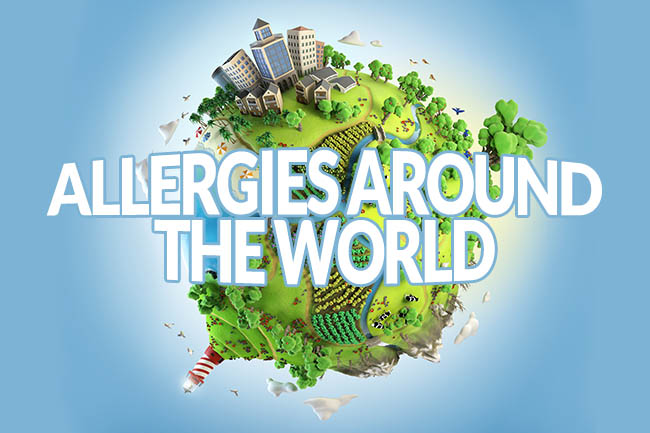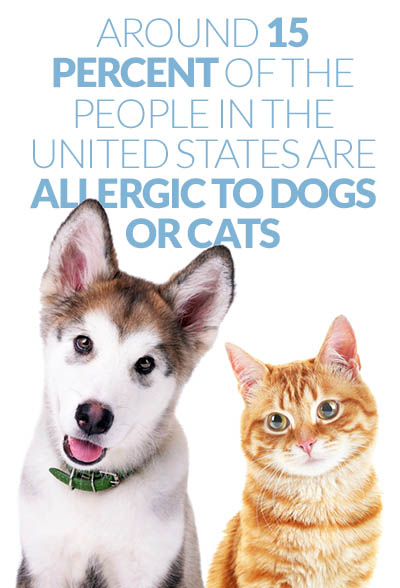
 Allergies are the most common form of chronic disease, and they affect millions of people around the world every day. Although they fall under the label “disease,” allergies are just the body’s extreme response to usually non-threatening elements. You develop an allergy when your immune system encounters an unfamiliar substance and overacts to it.
Allergies are the most common form of chronic disease, and they affect millions of people around the world every day. Although they fall under the label “disease,” allergies are just the body’s extreme response to usually non-threatening elements. You develop an allergy when your immune system encounters an unfamiliar substance and overacts to it.
The typical symptoms associated with allergies, such as a runny nose, itching, rashes, watery eyes, sneezing and inflammation, are the body’s hypersensitized response to otherwise harmless stimuli. Several types of allergens prompt allergic reactions, but the most universal are food and environmental.
Food Allergies
Several factors contribute to global allergy patterns. However, data suggests that most people develop allergies to foods typically eaten in the areas where they live.
For example, milk and eggs are very common food items around the world, so it’s not surprising that they rank among the top five food most common allergies around the world. Most children outgrow their food sensitivities. But for those whose allergic reactions persist into adulthood, eating certain foods can have uncomfortable and even fatal side effects.
 Nuts
Nuts
Tree nuts like almonds, cashews and pistachios make up about ninety percent of all food allergens. Of that number, peanut allergies are the most common.
Globally, about three percent of infants one year or younger exhibit some form of peanut sensitivity. Moreover, though only about one percent of the population claim to have a peanut allergy, it’s still considered a pandemic ailment. Peanut allergies are more common in the West than they are in Latin or East Asian countries, and the reason apparently lies in how each region prepares its food.

Just as allergy-inducing factors in the environment differ from one country or continent to another, the way a country prepares its food can affect how the body reacts when it’s ingested. A 2014 Oxford study, published in the Journal of Allergy and Clinical Immunology, suggested that the dry-roasting method the U.S. and other Western countries employ is more likely to trigger allergic reactions than processes East Asian countries use like boiling, frying or eating peanuts raw.
Allergic reactions to nuts can be dangerous, and the only defense against them is avoidance or an injectable hormone called “epinephrine”. However, substituting industry preparation standards may be a promising way to reduce the severity of these reactions.
 Seafood and Crustaceans
Seafood and Crustaceans
In the U.S., seafood allergies, especially sensitivities to shellfish, affects more than five percent of the population. Canada, Mexico and coastal areas of Latin America all list seafood as one of their five most common allergens.
 Still, Asia has the most reported cases of seafood allergies, partially because of how many individuals live in this combined region. According to a report published in the Asia Pacific Allergy scientific journal, about five percent of older teenagers in Southeast Asian countries suffer from crustacean allergies, whereas in the United States, less than one percent exhibit allergy symptoms.
Still, Asia has the most reported cases of seafood allergies, partially because of how many individuals live in this combined region. According to a report published in the Asia Pacific Allergy scientific journal, about five percent of older teenagers in Southeast Asian countries suffer from crustacean allergies, whereas in the United States, less than one percent exhibit allergy symptoms.
Europeans countries that consume a lot of fish like Norway and Finland also report higher percentages of seafood allergies. For these areas, after peanuts, shellfish is the greatest instigator of potentially life-threatening allergic reactions.
In contrast, seafood isn’t as much of an issue in Japan and South Korea. Despite these countries’ propensity for including seafood in traditional dishes (Japan more than South Korea), fish, mollusk and crustacean allergies aren’t listed among the top five of either country. For the small percentage of individuals who do suffer from seafood allergies in these areas, hypersensitivity to Anisaki, a type of parasitic worm found in marine animals, is normal.
Once again, food preparation practices come into play. Anisaki allergies are almost unheard of in the United States because eating raw fish isn’t customary. But, this might change as sushi and sashimi continue to grow in popularity in America’s coastal areas. Spain, which has a popular traditional dish made from pickled sardines, is another country with several cases of Anisaki hypersensitivity.
Like tree nut allergies, seafood allergies can be fatal if not addressed immediately. However, unlike tree nuts, there’s little the food industry can do to make this allergy less severe. The only defenses against a serious reaction are epinephrine and avoidance.

Rice
Japan differs in the fish allergy trends of its regional neighbors, but it fits the model when it comes to rice allergies. Sensitivity to rice proteins is uncommon in North America (not including Mexico) and Europe, where wheat byproducts are a staple. In East Asia and West African countries like Liberia, Ghana and Côte d’Ivoire, where the populace eats far more rice than wheat, this type of allergy is more common.
Nevertheless, rice is one of the least likely foods to cause an allergic reaction. The exact numbers of how many individuals exhibit rice allergy symptoms is difficult to determine, because confirmed cases are rarely reported. As with most other food allergens, avoiding rice is the only way to prevent a reaction if you suspect you have a rice sensitivity.
 Sesame and Wheat
Sesame and Wheat
 Sesame is another rare food allergy in the United States because cooks generally use it as a garnish. Sesame is only the ninth most prevalent global food allergen, but in countries like Israel, whose traditional dishes contain a lot of sesame, sesame allergies are high. Because sesame seed oil is a common ingredient in medicinal and beauty products, it can be difficult to avoid.
Sesame is another rare food allergy in the United States because cooks generally use it as a garnish. Sesame is only the ninth most prevalent global food allergen, but in countries like Israel, whose traditional dishes contain a lot of sesame, sesame allergies are high. Because sesame seed oil is a common ingredient in medicinal and beauty products, it can be difficult to avoid.
On the other hand, wheat ranks just after tree nuts seafood, and milk as the most frequently reported food allergen. Wheat allergy, also known as celiac disease, is a hereditary intolerance to wheat and wheat by-products.
Although all allergies are the result of a hyperactive immune system, the medical community categorizes celiac disease as an autoimmune disease because it involves the body attacking its own cells. When a celiac eats food with wheat or gluten, the immune system is attacked, destroying the lining of the small intestine. This results in swelling, nausea and various difficulties during digestion.
A 2006 study claimed that as much as one percent of the U.S. population has a form of wheat intolerance, but more recent research states the percentage is slightly lower. Celiac disease is a widespread condition, but only Brazil lists it among the five most endemic allergies.
People in Asia, particularly China and Japan, seem to have a higher intolerance for buckwheat, which, despite the similarities of its name, isn’t a wheat relative. Because gluten is a fundamental ingredient in many Western dishes and processed foods, eating at restaurants can be challenging for anyone with a wheat allergy.

Soy
Despite the recent rise in its popularity, most humans are unable to fully digest soy. Soy does have nutritional benefits, but they aren’t as numerous as pop culture health fads would have you believe. Vegans, vegetarians and those with meat allergies often use soy products as a dietary substitute without realizing that soy contains elevated levels of aluminum and other compounds that interfere with digestion.
Like peanuts and raw fish, the secret to making soy more compatible with the body is in how it’s prepared. In East Asia, particularly Japan, people eat fermented soy products because they are easier to digest. Once soy undergoes the fermentation process, it loses most of its negative dietary components.
Raw soybeans and tofu are fine to eat infrequently. However, if you want to add larger quantities of soy to your diet, choose fermented soy products like tempeh, natto, soy sauce or miso.
Besides people’s general intolerance for soy, acute soy allergies are normal in various countries around the world. According to the U.S. Department of Agriculture, there are as many as 15 different proteins in soybeans that induce allergic reactions in humans.
Unfortunately, most processed foods contain soy, and fast food restaurants notoriously include soy in their recipes. Individuals with soy sensitivities will encounter similar challenges as those with gluten allergies, so they need to carefully review the ingredients in their food before eating them.
 Milk and Eggs
Milk and Eggs
 Milk and eggs are two of the world’s most common food allergens. Nearly every country (except a few in West Africa) list either or both as one of that region’s top-five allergens. As with soy, most adult digestive systems have trouble breaking down milk, because about three-fourths of the world’s populace lose their lactose enzymes when they stop breastfeeding.
Milk and eggs are two of the world’s most common food allergens. Nearly every country (except a few in West Africa) list either or both as one of that region’s top-five allergens. As with soy, most adult digestive systems have trouble breaking down milk, because about three-fourths of the world’s populace lose their lactose enzymes when they stop breastfeeding.
This deficiency leads to a general intolerance for dairy and its products. However, you can remedy the problem by taking lactose pills before eating dairy foods. Nonetheless, lactose intolerance and lactose deficiency aren’t food allergies.
People who are allergic to milk proteins show signs of sensitively in early childhood, and the condition usually remains even after they become an adult. Individuals with milk allergies shouldn’t confuse it with intolerance and take lactose pills. Avoiding dairy in your diet is the only way to prevent the more serious symptoms associated with food allergies.
As for eggs, they trigger allergic reactions in children so often that pediatricians advise against feeding eggs to kids before they are 12 months old. In the past, most parents discovered their child’s egg allergy through their reaction to egg-based vaccines like the measles-mumps-rubella (MMR) and influenza shots. However, in recent years, these shots have become much safer for acutely allergic children.

Environmental Allergies
Ninety percent of the world’s most prevalent allergens are food or food-related. However, this doesn’t mean that the less common environmental allergens aren’t as serious. According to the World Health Organization, allergic rhinitis or hay fever affects approximately ten to thirty percent of the global population, and that number has been steadily increasing.
Moreover, environmental allergens aren’t limited to the outdoors. Individuals with histories of respiratory issues, like asthma, may also find they have a higher sensitivity to dust, dust mites, fur and pet dander.

Outdoor Allergens
Pollen, fungal spores and grasses are the primary cause of allergic rhinitis (Hay fever) and allergic conjunctivitis (pink eye). As with other types of allergies, when individuals with seasonal allergies encounter spores and pollen grains, their immune systems react act as if a dangerous substance has entered their body. To most, allergic rhinitis seems harmless, but this respiratory allergy can be dangerous if not taken seriously.
 Airborne allergens can trigger asthma symptoms and exasperate already present symptoms of allergic rhinitis. Most physicians recommend eye drops and nasal sprays to provide allergy relief. Unlike pink eye born from E. coli bacteria or viruses, allergic conjunctivitis isn’t contagious and is virtually harmless. Doctors also recommend using a quality HEPA air purifier to help clean and rid the air in your home of outdoor allergens.
Airborne allergens can trigger asthma symptoms and exasperate already present symptoms of allergic rhinitis. Most physicians recommend eye drops and nasal sprays to provide allergy relief. Unlike pink eye born from E. coli bacteria or viruses, allergic conjunctivitis isn’t contagious and is virtually harmless. Doctors also recommend using a quality HEPA air purifier to help clean and rid the air in your home of outdoor allergens.
In East Asian countries, particularly Japan, South Korea and China, wearing a pollen mask is a common, non-medical way to combat allergies and prevent the spread of cold-inducing bacteria. The masks help filter out allergy-inducing pollen grains and mold spores and make the simple act of breathing much easier for people with seasonal allergies.
Medical studies indicate that triggers for allergic rhinitis have increased over the past 30 years, citing global climate change and the increase in air pollutants for people’s heightened sensitivity to respiratory allergic illnesses. Therefore, it’s common to see children develop allergies in cities with moderate to severe levels of pollution like Los Angeles, Hong Kong, Dammam (Saudi Arabia) and Kanpur (India).

Pet Allergies
 Around 15 percent of the people in the United States are allergic to dogs or cats, and most people believe that excess pet fur causes those allergies. The root of a pet allergy is the same as any another: harmless proteins the body classifies as dangerous invaders. Proteins in the saliva, dander and urine of pets can set off an allergic reaction in the body.
Around 15 percent of the people in the United States are allergic to dogs or cats, and most people believe that excess pet fur causes those allergies. The root of a pet allergy is the same as any another: harmless proteins the body classifies as dangerous invaders. Proteins in the saliva, dander and urine of pets can set off an allergic reaction in the body.
Symptoms can be as mild as a slight cough or as severe as anaphylaxis (a life-threatening allergic reaction). Owning a pet also increases your risk of having dust mites. Mites are parasitic arachnids that are similar to ticks and a leading cause of cause of perennial allergic rhinitis.
Seasonal allergic rhinitis symptoms disappear once seasons change, but perennial allergic rhinitis is a year-round problem. Mites like warm, humid areas, terrorizing your pets by laying eggs under their skin. These bugs are less of an issue in colder, dryer climates, so people in mountainous areas of the world don’t encounter them often.
Individuals who are acutely allergic to pets should avoid contact with animals as much as possible. However, you can manage most cases of a mild pet or dust mite allergy with medication, frequent cleaning and a home dehumidifier. Home dehumidifiers remove excess moisture from the air, which kills off dust mite, mold and mildew populations by making it harder for them to survive in your home.
